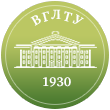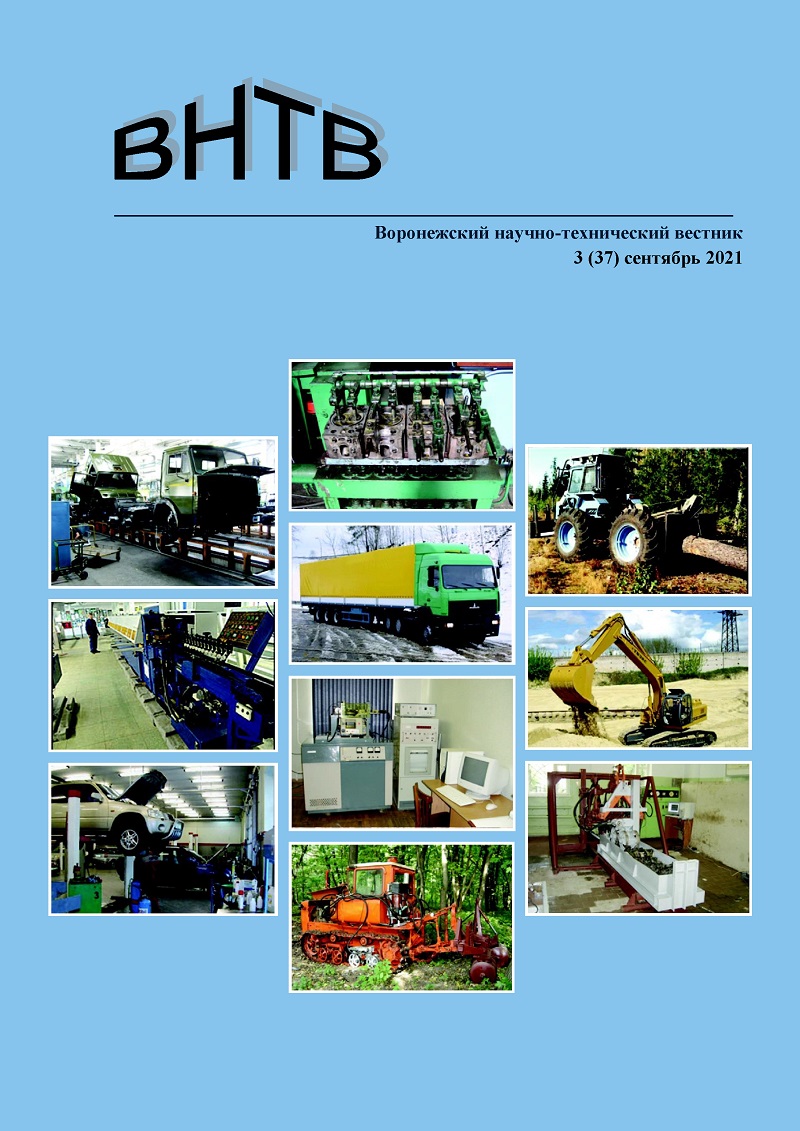UDC 539
UDC 621
The results of the study of the dependence of the temperature of the friction zone of two bodies (shaft and the inner sleeve) are presented from the operational parameters of the sliding bearing, such as pressure, slip speed and radial load in the resource aspect of the friction pair. On the basis of a multi-factor experiment, the regression of the friction process was obtained, which takes into account the influence of these parameters on the temperature in the contact zone, which makes it possible to determine the borders of the trouble-free operation of the friction of motor vehicles. Technological ways are proposed to solve the problematic performance of the friction pair on the temperature criterion without scoring.
SLIDING BEARING, FRICTION, TEMPERATURE, SPECIFIC PRESSURE, SLIDING SPEED, RADIAL LOAD, EXPERIMENT, RELIABILITY.
|
DOI:
|
|
|
УДК 539.621: 303.447.3
|
|
|
05.22.10 – эксплуатация автомобильного транспорта
|
|
|
ЭКСПЛУАТАЦИОННЫХ ПАРАМЕТРОВ ПОДШИПНИКОВ СКОЛЬЖЕНИЯ АВТОТРАНСПОРНЫХ МАШИН НА ТЕМПЕРАТУРУ В ЗОНЕ ТРЕНИЯ КАК ФАКТОР РЕСУРСА
|
REGULARITIES OF THE INFLUENCE OF OPERATING PARAMETERS OF SLIDING BEARINGS OF AUTO-TRANSPORT MACHINES ON THE TEMPERATURE IN THE FRICTION ZONE AS A RESOURCE FACTOR
|
|
Жачкин Сергей Юрьевич д.т.н., профессор кафедры автоматизированного оборудования машиностроительного производства Воронежского государственного технического университета (ВГТУ), Воронеж, Россия
|
Zhachkin Sergey Yurievich doctor of technical sciences, professor of the Department of Automated Equipment of Machine-Building Production of the Voronezh State Technical University, Russia
|
|
Пеньков Никита Алексеевич к.т.н., начальник лаборатории ВУНЦ ВВС «Военно-воздушная академия имени профессора Н. Е. Жуковского и Ю. А. Гагарина», Воронеж, Россия,
|
Penkov Nikita Alexeyevich candidate of technical sciences, head of the laboratory the Air Force Academy named after Professor N. E. Zhukovsky
|
|
Лазарев Сергей Викторович к.т.н., доцент, начальник кафедры аэродромно-технических средств ВУНЦ ВВС «Военно-воздушная академия имени профессора Н. Е. Жуковского и Ю. А. Гагарина», Воронеж, Россия.
|
Lazarev Sergey Viktorovich candidate of technical sciences, associate professor, head of the department of Aerodrome Equipment the Air Force Academy named after Professor N. E. Zhukovsky and Yu. A. Gagarin, Russia.
|
|
младший научный сотрудник ВУНЦ ВВС «Военно-воздушная академия имени профессора Н. Е. Жуковского и Ю. А. Гагарина», Воронеж, Россия, e-mail: trifonov_gi@mail.ru
|
junior researcher the Air Force Academy named after Professor N. E. Zhukovsky and Yu. A. Gagarin, Russia, e-mail: trifonov_gi@mail.ru
|
|
Аннотация. Представлены результаты исследования зависимости температуры зоны трения двух тел (вал и внутренняя втулка) от эксплуатационных параметров подшипника скольжения, таких как давление, скорость скольжения и радиальная нагрузка в аспекте ресурса пары трения. На основе многофакторного эксперимента получено уравнение регрессии процесса трения, учитывающего влияние данных параметров на температуру в зоне контакта, позволяющего определять границы безотказной работы пар трения автотранспортной техники. Предложены технологические пути решения обеспечения заданной работоспособности пары трения по температурному критерию без задиров.
|
Annotation. The results of the study of the dependence of the temperature of the friction zone of two bodies (shaft and the inner sleeve) are presented from the operational parameters of the sliding bearing, such as pressure, slip speed and radial load in the resource aspect of the friction pair. On the basis of a multi-factor experiment, the regression of the friction process was obtained, which takes into account the influence of these parameters on the temperature in the contact zone, which makes it possible to determine the borders of the trouble-free operation of the friction of motor vehicles. Technological ways are proposed to solve the problematic performance of the friction pair on the temperature criterion without scoring.
|
|
Ключевые слова: ПОДШИПНИК СКОЛЬЖЕНИЯ, ТРЕНИЕ, ТЕМПЕРАТУРА, ДАВЛЕНИЕ, СКОРОСТЬ СКОЛЬЖЕНИЯ, РАДИАЛЬНАЯ НАГРУЗКА, ЭКСПЕРИМЕНТ, БЕЗОТКАЗНОСТЬ.
|
Keywords: SLIDING BEARING, FRICTION, TEMPERATURE, SPECIFIC PRESSURE, SLIDING SPEED, RADIAL LOAD, EXPERIMENT, RELIABILITY.
|
|
1Автор для ведения переписки |
|
1 Состояние исследования и актуальность работы
При эксплуатации специальной и автотранспортной техники, в частности автомобилей, в их конструкциях используются подшипники скольжения (полукольца, втулки). Как известно [1-3], основным эксплуатационным фактором, влияющим на величину ресурса деталей особенно в условиях сухого и граничного трения, является их износостойкость. Стоит отметить, что при эксплуатации, ввиду разнопеременных нагрузок, величина износостойкости, безотказность работы, а, следовательно, и ресурс будут зависеть от назначенных режимов работы.
При работе в режиме граничного трения или трения без смазки сопротивляемость изнашиванию и образованию задиров во многом определяется видом материала, из которого изготовлена деталь [4]. И как следствие выбор элементов трущейся пары производится с учетом их совместимости.
На сегодняшний день целый спектр исследований посвящен основам трения, в частности, парам сухого и граничного трения [5-8], а также изучению физико-механических свойств трущихся тел, что позволяет опытным путем рассчитывать необходимые эксплуатационные параметры для дальнейшей работы деталей и механизмов в целом.
Испытания материалов на износ в условия сухого трения являются наиболее экстремальными и позволяют объективно оценить износостойкость сопряжений ни только при сухом, но жидкостном и граничном трении, а также сократить длительность испытаний.
Целью данной работ является исследование и анализ температуры в зоне активного трения двух тел в зависимости от таких параметров, как давление, скорость скольжения и радиальная нагрузка.
1. Kragelsky I. V., Alisin V. V. Friction wear lubrication handbook // Moscow : Mashinostroenie, 1978. Book 1. - 400 p.
2. Chichinadze A. V., Berliner E. M., Brown E. D., etc. Friction, wear and lubrication (tribology and tribotechnics). - Moscow : Mashinostroenie, 2003. - 576 p.
3. Hopin P. N. Evaluation of durability of solid lubricating coatings based on the analysis of the topography of friction surfaces // Friction and Wear, 1995, vol. 16, №. 4. - pp. 787-793.
4. Bartenev G. M., Lavrentiev V. V. Friction and wear of polymers. - L. : Chemistry, 1972. - 240 p.
5. Landau L. D. Theory of elasticity / L. D. Landau, E. M. Lifshits. - M. : Nauka, 1965. - 202 p.
6. Leonov S. L. Modeling of wear of deposited surfaces of parts / S. L. Leonov, A. A. Sitnikov, M. E. Tatarkin. - Polzunovsky Almanac, 2012, №. 1. - pp. 228-229.
7. Postnikov V. S. Internal friction in metals / V. S. Postnikov - M. : Metallurgy, 1974. - 351 p.
8. Yarosh V. M., Moisheev A. A., Bronovets M. A. Investigation of materials for friction and wear in open space in orbit around the Moon // Friction and wear, 2003, vol. 24, №. 6. - pp. 626-635.
9. Zhachkin S. Yu. Development of an algorithm for evaluating the physico-mechanical wear resistance of dry friction pairs of the aircraft pivot device / S. Yu. Zhachkin, G. I. Trifonov, A. V. Bakumenko // Aerospace forces. Theory and practice. Issue №. 12. 2019. - pp. 194-206.
10. Vintage of steels and alloys. 4th ed., reworked. and additional / Yu. G. Dragunov, A. S. Zubchenko, Yu. V. Kashirsky, etc. Under the general editorship of Yu. G. Dragunov and A. S. Zubchenko - M. : 2014. - 1216 p.
11. Trifonov G. I. Improvement of aircraft sliding bearings with the help of gas-thermal treatment and design modifications / G. I. Trifonov, D. V. Mitrofanov // Aerospace forces. Theory and practice. Issue №. 4. 2017. - pp. 61-68.
12. Ikramov U. A. Computational methods for assessing abrasive wear. - M. : Mechanical Engineering, 1987. - 288 p.
13. Leshchinsky L. K. Plasma surface hardening / L. K. Leshchinsky, S. S. Samotugin I. I. Pirch, V. I. Komar // K. : Tekhnika, 1990. - 109 p.
14. Grachev Yu. P., Plaksin Yu. M. Mathematical methods of experiment planning. - M. : Delhi print, 2005. - 296 p.
15. The use of a full factorial experiment in conducting research: method. instructions / comp. A. N. Gaidadin, S. A. Efremova // VolgSTU. - Volgograd, 2008. - 16 p.
16. Hartman K. et al. Planning an experiment in the study of technological processes. - M. : «Mir», 1977. - 552 p.
17. Adler Yu. P. Experiment planning in the search for optimal conditions / Yu. P. Adler, E. V. Markova, Yu. V. Granovsky // USSR Academy of Sciences. Sci. advice on the complex problem of «Cybernetics». Section «Mathematical theory of experiment». 2nd ed., reprint. and additional - Moscow : Nauka, 1976. - 279 p.
18. Mathematical theory of experiment planning / Edited by S. M. Ermakov. - M. : Nauka. The main edition of the physical and mathematical literature, 1983. - 392 p.
19. Weather, L. I. Improving the reliability of triberers / L. I. Weather, V. N. Kuzmin, P. P. Dudko. - C-PB: Academy of Transport of the Russian Federation, 2001. - 304 p.
20. Tenenbaum M. M. Resistance to abrasive wear // Moscow : Mashinostroenie, 1976. - 271 p.
21. Bely V. A. Friction and wear of polymer-based materials / V. A. Bely, A. I. Sviridenok, M. I. Petrovets, V. G. Savkin. - Minsk. : Science and Technology, 1976. - 432 p.












